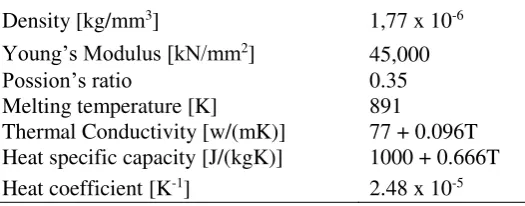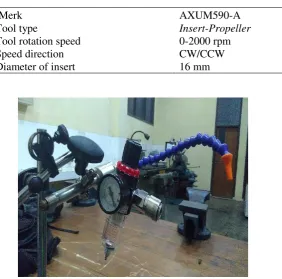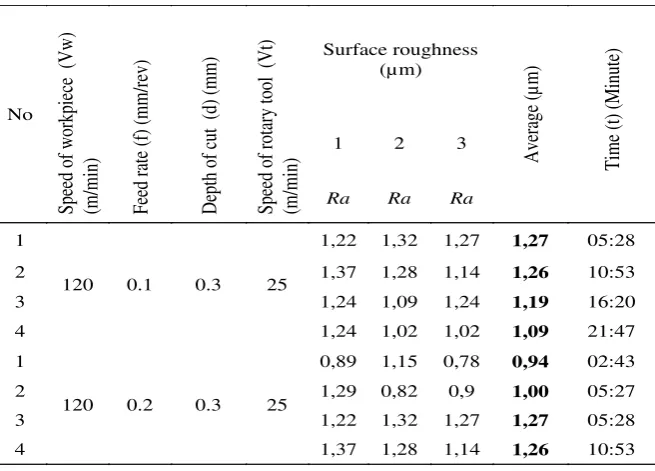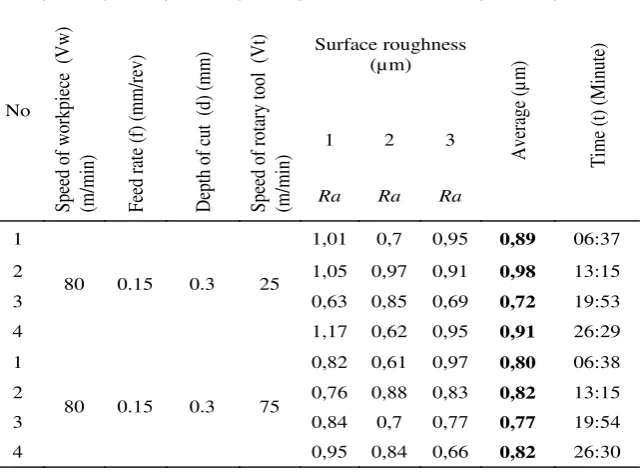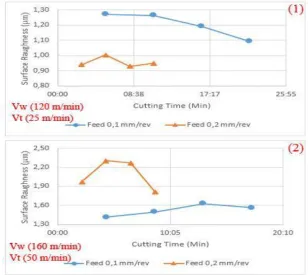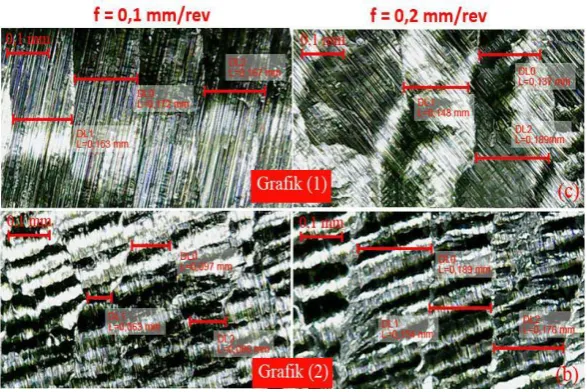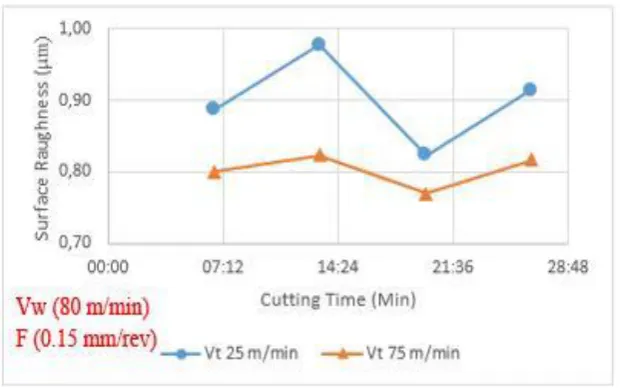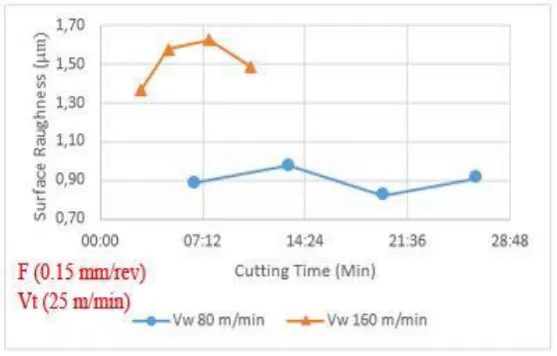IOP Conference Series: Materials Science and Engineering
PAPER • OPEN ACCESS
The machined surface of magnesium AZ31 after
rotary turning at air cooling condition
To cite this article: G Akhyar et al 2018 IOP Conf. Ser.: Mater. Sci. Eng.344 012004
View the article online for updates and enhancements.
Related content
Experimental investigation on hard turning of AISI 4340 steel using cemented coated carbide insert
J Pradeep Kumar, K P Kishore, M Ranjith Kumar et al.
-Analyzing the effect of cutting parameters on surface roughness and tool wear when machining nickel based hastelloy – 276
Basim A Khidhir and Bashir Mohamed
-An application of eddy current damping effect on single point diamond turning of titanium alloys
-1
Content from this work may be used under the terms of theCreative Commons Attribution 3.0 licence. Any further distribution of this work must maintain attribution to the author(s) and the title of the work, journal citation and DOI.
Published under licence by IOP Publishing Ltd
1234567890‘’“”
3rd IC-STAR 2017 IOP Publishing
IOP Conf. Series: Materials Science and Engineering 344 (2018) 012004 doi:10.1088/1757-899X/344/1/012004
The machined surface of magnesium AZ31 after rotary
turning at air cooling condition
G Akhyar 1*, B Purnomo 1, A Hamni 1, S Harun 1, Y Burhanuddin1
Department of Mechanical Engineering, Faculty of Engineering, University of Lampung. Jln. Prof.Sumantri Brojonegoro No.1 Gedung H FT Lt.2 Bandar Lampung
Email: [email protected]
1234567890‘’“”
3rd IC-STAR 2017 IOP Publishing
IOP Conf. Series: Materials Science and Engineering 344 (2018) 012004 doi:10.1088/1757-899X/344/1/012004
In addressing these issues, numerous studies have been conducted to find an effective method to reduce the cutting temperature. As stated by previous researchers that a high cutting temperatures will produce a high surface roughness values [5]. Because the machining process with high temperature will cause occurrence of wear on the cutting tool so that it can degrade the quality of the workpiece surface roughness [6].
In the machining process, generally the method that is widely used to lower the temperature of cutting is to use liquid. But in its development began to minimized use this liquid because it is very dangerous for health and the environment [3]. In the study conducted by Doni [7] which aims to analyze the surface roughness value by lowering the temperature of the cutting. The chosen method is to use a rotating cutting tool on a lathe machining processes without coolant and use a rotary tool tilt angle of 0° with respect to the workpiece. Rotary tool method used successfully obtain minimum surface roughness value of 0.62 μm and a maximum surface roughness values of 2.86 μm. In his research, Doni [7] recommends using low feed rate , because the higher of feed rate will generate greater roughness values. Research on machining magnesium is also done by Andriyansyah [8] which aims to determine the effect of cutting parameters on surface roughness values of magnesium using air cooling of vortex tube cooler with a temperature of 15° C. Machining process used is a milling machining. Research results show that the value of the minimum surface roughness of 0.35 μm and maximum roughness value of 1.50 μm.
of the research that has been described above concludes that the value of the surface roughness of magnesium in addition influenced by cutting parameters, including feed rate and the cutting speed, also influenced by the temperature of the cutting. Therefore in this study will be analyzed on a surface roughness values lathe machining process using a rotary cutting tool with a tilt angle of 10 °. In a previous study of this corner enabled to reduce power by 30% of the total power use and reduce the amount of cutting force [9] [10]. The cutting process will be given air cooling output of vortex tube cooler constant. By using cold air is expected to reduce the temperature of the cutting so as to reduce the rate of tool wear and improve tool life [11] [12]. So this method is expected to produce a better roughness values and can be used as a substitute for innovation in the machining process fluid.
The purpose of this study is to obtain the value of surface roughness and implement methods of cutting tool rotary tool and air cooling output of vortex tube cooler to minimize the surface roughness values.
2.Research Methodology
Laboratory of Manufacturing, Mechanical Engineering, Lampung University. Materials used in the study are magnesium alloy AZ31 (Al of 3% and Zinc of 1%). Here is an AZ31 magnesium physical
table property.
Table 1. Physical properties of magnesium AZ31
Density [kg/mm3] 1,77 x 10-6
Young’s Modulus [kN/mm2] 45,000
Possion’s ratio 0.35
Melting temperature [K] 891
Thermal Conductivity [w/(mK)] 77 + 0.096T
Heat specific capacity [J/(kgK)] 1000 + 0.666T
3
1234567890‘’“”
3rd IC-STAR 2017 IOP Publishing
IOP Conf. Series: Materials Science and Engineering 344 (2018) 012004 doi:10.1088/1757-899X/344/1/012004
The machining is done on conventional lathes brands PINACHO type S-90/200. By using a rotary cutting tool system as shown in Figure 1. The material of tool used is a carbide, diameter of 16 mm and the air cooling pressure of 6 bar. Here are the figure and specifications of the tool cutting system
spins and vortex tube :
Figure 1. Rotary cutting tool system
Table 2. Specifications of rotary tool
Merk AXUM590-A
Tool type Insert-Propeller
Tool rotation speed 0-2000 rpm
Speed direction CW/CCW
Diameter of insert 16 mm
1234567890‘’“”
3rd IC-STAR 2017 IOP Publishing
IOP Conf. Series: Materials Science and Engineering 344 (2018) 012004 doi:10.1088/1757-899X/344/1/012004
Machining parameters that is turning using rotary cutting tool at speed the workpiece of (Vw), cutting speed of rotary tool of (Vt), feed rate (f), depth of cut (d). Can be seen in Table 3.
Table 3. Cutting parameters selected in turning process.
Speed of
Data collection roughness on every parameter done four times. This is done to get the maximum results. Measurement values using a surface roughness tester with an accuracy of 0.01 μm and surface profile of picture a using USB camera with a magnification of 600 x.
3.Results and Discussions
In Experimental trials of AZ31 magnesium alloys using conventional turning and rotary cutting tool system with air cooling. To determine the value of the surface roughness material magnesium alloy AZ31 has been carried out with a variety of machining parameters that is turning using rotary cutting tool at speed the workpiece of (Vw) 50, 120, 160 m/min, cutting speed of rotary tool of (Vt) 25, 50, 75 m/min, feed rate of (f) 0.1, 0.15, 0.2 mm/rev, and depth of cut of 0.3 mm. Here are the data obtained from the machining process with a variety of conditions, produces a variety of data as shown in Table 4-7:
Table 4. Measurement data value of roughness on speed the workpiece of 120 m/min, depth of cut of 0.3 mm, and cutting speed of rotary tool
5
1234567890‘’“”
3rd IC-STAR 2017 IOP Publishing
IOP Conf. Series: Materials Science and Engineering 344 (2018) 012004 doi:10.1088/1757-899X/344/1/012004
Table 5. Measurement data value of roughness on speed the workpiece of 160 m/min, depth of cut of 0.3 mm, and cutting speed rotary tool of
50 m/min.
Table 6. Measurement data value of roughness on speed the workpiece of 80 m/min, feed rate of 0.15 mm/rev, and depth of cut
1234567890‘’“”
3rd IC-STAR 2017 IOP Publishing
IOP Conf. Series: Materials Science and Engineering 344 (2018) 012004 doi:10.1088/1757-899X/344/1/012004
Table 7. Measurement data value raughness on the feed rate 0.15 mm/rev, depth of cut 0.3 mm, and cutting speed of rotary tool of 25 m/min
3.1.Feed rate and surface roughness value
The following is a graph showing the comparison surface roughness values between feed rate 0.1 mm/rev and 0.2 mm/rev at the depth of cut (d) 0.3 mm.
7
1234567890‘’“”
3rd IC-STAR 2017 IOP Publishing
IOP Conf. Series: Materials Science and Engineering 344 (2018) 012004 doi:10.1088/1757-899X/344/1/012004
Figure 3 is a comparison of the effect of feed rate on the value of surface roughness. Where in graph 1 surface roughness value was lower than in the feed rate of 0.2 mm/rev. It is inversely proportional to the statement earlier researchers [7]. Which states that the chip of feed is very influential on the surface roughness, where the greater the price of feed. the greater the level of coarseness. But in general, the value of the surface roughness is influenced by a variety of many factors. These factors include other parameters of the machining process, the condition of the tool, the workpiece and the cutting phenomenon [13] [14]. From the statement of course in this case the value of the feed is not completely affect the value of the resulting roughness.
Whereas in Figure 2 the surface roughness value was lowest in the feed rate 0.1 mm/rev. In both cases carried out observations of the surface profile, wherein the surface profile measurements to feed mark the resulting on cutting scars. Here is a comparison of the measured surface profile of the workpiece :
Figure 4. Comparison between profiles of feed rate (f) 0.1 and 0.2 mm/rev.
In Figure 4 obtained value feed mark on the first surface profile of feed rate 0.1 mm/rev of 0.164 mm and feed rate 0.2 mm/rev of 0.158 mm. While the second profile feed rate 0.1 mm/rev produce value feed mark of 0.082 mm and feed rate 0.2 mm/rev of 0.173 mm.
3.2.Cutting speed Rotary and surface roughness value
1234567890‘’“”
3rd IC-STAR 2017 IOP Publishing
IOP Conf. Series: Materials Science and Engineering 344 (2018) 012004 doi:10.1088/1757-899X/344/1/012004
Figure 5 . Graph comparison of cutting speed of rotary tool (Vt) of the surface roughness values.
Figure 5 is a comparison of the effect of cutting speed rotary tool against the surface roughness values. Where is concluded that the value of the surface roughness was lowest in the cutting speed of rotary tool (Vt) 75 m/min and the surface roughness values were highest in cutting speed of rotary tool (Vt) 25 m/min. As already stated by Doni [7], the greater the cutting speed of the rotary cutting tool resulting roughness value would be lower. For a comparison of the surface profile can be seen in Figure 6.
Figure 6. Comparison between the profile cutting speed of rotary tool 25 and 75 m/min.
3.3.Workpiece speed and surface roughness value
9
1234567890‘’“”
3rd IC-STAR 2017 IOP Publishing
IOP Conf. Series: Materials Science and Engineering 344 (2018) 012004 doi:10.1088/1757-899X/344/1/012004
Figure 7. Graph speed the workpiece (Vw) of the surface roughness values.
Figure 7 is a comparison of the effect of speed of workpiece on the value of surface roughness. Where is concluded that the value of surface roughness was lowest in the speed of workpiece of 80 m/min and the highest surface roughness values occur at the speed of workpiece 160 m/min. As stated by Fariza [15] in his study, the greater the speed of workpiece then the resulting roughness value will be higher. For a comparison of the surface profile can be seen in Figure 8.
Figure 8. Comparison between the velocity profile speed of workpiece 80 and 160 m/min..
4.Conclusions
1234567890‘’“”
3rd IC-STAR 2017 IOP Publishing
IOP Conf. Series: Materials Science and Engineering 344 (2018) 012004 doi:10.1088/1757-899X/344/1/012004
2. Values of surface roughness is not uniform throughout the machining process, this is due to tool wear is not uniform along the edge of the rotary cutting tool.
3. Values of surface roughness parameters are more influenced by the speed of the workpiece (Vw) and the cutting speed of rotary tool (Vt). Higher speed of the workpiece (Vw) then the surface roughness of the resulting higher. Instead higher cutting speed of rotary tool (Vt) then the value of the resulting surface roughness is lower.
4. Turning process using a rotary tool and air cooling can be implemented in a lathe machining process AZ31 magnesium material for producing a lower roughness values compared to using a silent tool.
References
[1] Ibrahim G A 2014 Analisa Kekasaran Permukaan pada Pemesinan Paduan Magnesium. Jurusan Teknik Mesin. Universitas Lampung. Bandar Lampung
[2] Blawert C, Hort N and Kainer K U 2004 Automotive Applications Of Magnesium And Its Alloys Trans Indian Inst. Met. Vol.57 No. 4 pp. 397- 408
[3] Harun S 2012 Peningkatan Produktifitas dan Pengendalian Suhu Pengapian Pemesinan Magnesium Dengan Sistem Pahat Putar (Rotary Tool System) dan Pendingin Udara (Air Cooling) Universitas Lampung. Bandar Lampung
[4] Mahrudi H, and Burhanuddin Y 2013 Rancang Bangun Aplikasi Thermovision Untuk Pemetaan Distribusi Suhu Dan Permulaan Penyalaan Magnesium Pada Pembubutan Kecepatan Tinggi Jurusan Teknik Mesin Universitas Lampung, Bandar Lampung.
[5] Bruni C, Forcellese A, Gabrielli F, and Simoncini M 2004 Effect Of Temperature, Strain Rate And Fibre Orientation On The Plastic Flow Behaviour And Formability Of AZ31 Magnesium Alloy Department of Mechanics Università Politecnica delle Marche Via Brecce Bianche Ancona 60131 Italy
[6] Su Y, He H, Li L, Iqbal A, Xiao, M H Xu, S Qiu, B G 2007 Refrigerated Cooling Air Cutting Of Difficult-To-Cut Materials International Journal of Machine Tools & Manufacture 47 927 – 933
[7] Doni A R 2015 Analisa Nilai Kekasaran Permukaan Paduan Magnesium AZ31 Yang Dibubut Menggunakan Pahat Potong Berputar. Tugas Akhir Universitas Lampung.
[8] Andriyansyah 2014 Pengaruh Parameter Pemotongan Terhadap Kekasaran permukaan Dalam Pengefreisan Magnesium Tersuplai Udara Dingin. Tugas Akhir. Universitas Lampung. [9] Akhmad Isnain P, Gusri A I, and Burhanuddin Y 2013 Unjuk Kerja Vortex Tube Cooler Pada
Pemesinan Baja St41. Jurnal FEMA. Universitas Lampung
[10] Paryanto R, an Tony S U 2012 Effect Of Air Jet Cooling On Surface Roughness And Tool Wear Jurnal Teknosains Universitas Diponegoro
[11] Stejernstoft T 2004 Machining of Some Difficult-to-Cut Materials with Rotary Cutting Tools Stockholm The Royal Institute of Technology KTH.
[12] Novriadi D 2016 Rancang Bangun Sistem Pahat Putar Modular (Modular Rotary Tool System) Untuk Pemesinan Alat Kesehatan Ortopedi Universitas Lampung Bandar Lampung
[13] Benardos P G, and Vosniakos G C 2003 Predicting surface roughness in machining: a review International Journal of Machine Tools & Manufacture 43 833 – 844.
[14] Salgado D R, Alonso F J, Cambero I, and Marcelo A 2009 In-process surface roughness prediction system using cutting vibrations in turning International Journal of Advance Manufacturing Technology 43 40 – 51.
